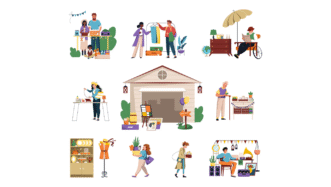LESSON OVERVIEW
In this ESL lesson about living in the country or a city, students learn some phrases related to village experiences, watch a 3-minute fragment of a video, read a short article and have a discussion.
B1 / Intermediate60 minStandard LessonUnlimited Plan
WARM-UP & VOCABULARY
The lesson starts with a warm-up activity. Students think about five things they associate with the word ‘city’ and the word ‘country’. Then, students move on and do a vocabulary activity. They match the sentence halves which include some phrases in bold (e.g. raise animals, milk cows, craft things from natural materials, etc.). Students also can decide which of the activities from the sentences people can do only while living in the country. After that, they discuss some more questions and talk about their experiences. Students do one more activity in which they complete the sentences so that they are true for them. In the next part of the lesson, students watch a video in which a woman is talking about living in the country, read a text and have discussions.
VIDEO & DISCUSSION
Before the viewing, students look at some things and guess how they might be connected to the video. Then, they watch the video (the first 3 minutes) and choose the correct sentence in each pair. Students discuss the video and talk more about living in the country. Then, students move on to a reading part. First, they look at the titles and guess what the articles might be about. After that, they read a short article about buying a one-euro house in Italy and match it to one of the titles. After reading, students share their thoughts about the contents of the article. The lesson finishes with an activity where students read the stories of people and decide whether they should be living in the country or a city.
HOMEWORK/REVISION
This ESL lesson also includes an additional task that you can use as homework or revision. In the task, students talk about the advantages and disadvantages of living in the country. The task is available in the teacher’s version of the worksheet. You can print it and hand it out to your students. It’s also included in the e-lesson plan.
Subscribe to unlock these and many other Standalone lesson lesson plans with the Unlimited planWORKSHEETS















I can’t wait to use this lesson for my students! Thank you!
Thank you so much, Inna! Hope you’ll share with us how the lesson turned out with your students 🙂
I loved this new layout!
I just miss having the page number and for matching exercises, some brackets so students don’t need to draw a line, they can write the corresponding letter or number.
Great to hear that, thanks! Regarding the page numbers, we don’t put them because there is usually more text in the teacher’s pdf than in the student’s so the numbering would be different in the two versions and it might cause too much confusion.
Great lesson, this new pdf design is so simple and good! =)
Thank you so much! We’re happy you like it 🙂
Thank you so much for sharing Inna. Great lesson.
Thank you so much for the comment, Marcia! Happy you enjoyed the lesson 🙂
How can I get free access to this lesson
To access this lesson, you need to have our Unlimited subscription. You can check this and other subscription plans here.
This is a perfect lesson to use with my students who live in a small rural German town–I can’t wait to try it with them!
Glad to hear that, Roberta! Hope your students enjoy the lesson 🙂